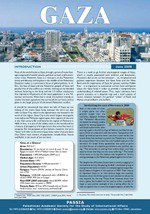GAZA Bulletin
Overview
Most of the world looks at Gaza through a prism of news footage comprised of missile attacks, political turmoil, and humanitarian crisis. However, Gaza is a vital part of the Palestinian entity and identity, and its place in the middle of the Palestinian Question makes it a prominent focus of global politics. In effect, the fate of Gaza and the Palestinian people of Gaza will parallel that of the conflict as a whole; nothing can be decided without factoring in the Strip and the 1.5 million inhabitants that represent 40 percent of the total population in the Palestinian territories. With that in mind, this bulletin intends to answer the basic questions that surround the territory and its place in the larger picture of the Israeli-Palestinian conflict. It should be mentioned that when we talk of Gaza we are talking of the entire Gaza Strip, because the term can also refer to Gaza City, which is the eponymous city located in the north of the region. Gaza City is the area’s largest metropolis; it served as the Philistine capital upon their capture of the area in the 13th century BC and became the capital of Palestine in 1660. In fact, it is one of the oldest cities in the world and has a history of prosperity and importance that stretches back to antiquity. For the purposes of this bulletin, however, the term “Gaza” will refer to the entire Gaza Strip rather than just Gaza City. Other main centers of population include Khan Younis and Rafah in the south of the territory. 1 Statistics from: a - PASSIA Diary 2008 b- PCBS (2007); c -UNRWA (June 2007), d- WorldBank (April 2008).There is a need to go further stereotypical images of Gaza, which is usually associated with violence and destitution.
Moreover, due to the current situation – i.e., the physical and political separation between the Gaza Strip and the West Bank and the importance of Gaza for greater stability Middle East – it is important to summarize current facts and figures about the Gaza Strip in order to provide a comprehensive
understanding of related issues. Thus, major elements from general statistics to a detailed map and a brief analysis of recent relations between the political “tribes” of Fateh and Hamas are provided in this bulletin.

